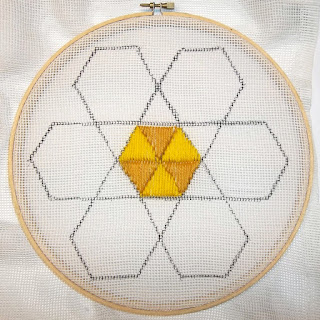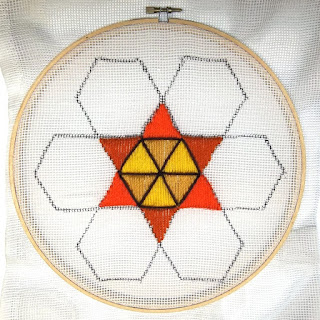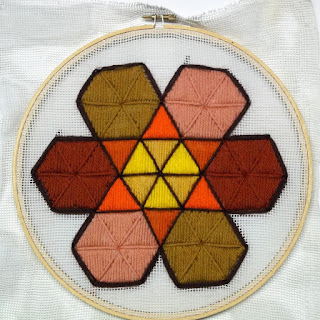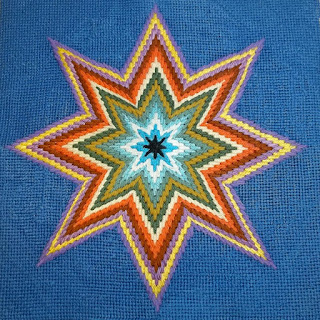 |
| 8-way Bargello Pillow Top |
This post, I'm trying to make good on some projects I promised earlier this year. The first one was to give you a pattern for a 6-way bargello design. We have already done 4-way bargellos and an 8-way bargello (above), but a 6-way is different because the design is based on 60-degree angles, rather than the familiar 90-degree and 45-degree ones. I have designed several of these, but we will be starting with a very simple one. There will be others next year, but they will be a little more difficult. I suggest that you study the posts on 4-way (December 22, 2014) and 8-way bargello (April 22, 2016) before you begin a 6-way project. You may find that you want to try one of the others first, but I assure you this one is probably easier. I'm going to take you step-by-step through this project. Let's begin with the design, which you can download.
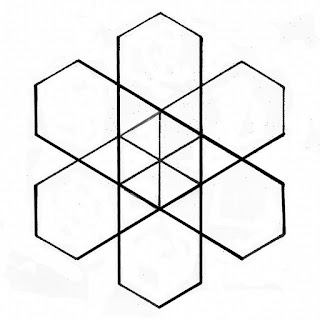 |
| Click here to download Pattern for 6-way Bargello |
Since this is a 6-sided design, it makes sense to start with a 6-sided figure, the hexagon. I began by finding the center of my paper and marking it with a dot. Then I constructed a hexagon with the dot at its center. I then made 6 more hexagons, each starting from a point, not a side, of the original one. (If you are constructing a design like this, rather than using a pattern, you may want to make a cardboard template of the center hexagon to draw around as you progress.) You will notice that each of the spaces between the outer and inner hexagons — as well as between each outer hexagon and its neighbor — is a triangle. Where the bases of two triangles touch, they form a diamond-shape. Finally, I divided the central hexagon into 6 equal triangles. This gave me a choice of triangles or diamonds to stitch. I then made several copies of the design and began to work it out in various color combinations. You can see some of the results below.
As I worked on the design, I told J.D. that I could see an optical illusion forming in one of the designs. He said he could see one, too, but that he would have to erase some of the lines in the design to make it. I suggested that we each draw the design we imagined to see if we had different illusions in mind. When we compared our results, we had indeed seen different illusions. (We were delighted, because another of my promises was to provide more optical illusion designs!) This “game” continued for some time. Below are two of the more interesting ones, for the benefit of those of you who have taken up this pursuit.
In the meantime, I prepared my canvas for the demonstration I'm going to show you now. For more information about preparing a canvas, see the post for May 11, 2014. I began with the triangles in the central hexagon. There are several ways to approach these triangles. An obvious one is to do two sets of triangles in two colors. That is, alternate the two colors as you move around the hexagon. To use three colors, work two adjacent triangles in the first color, the next two in the second color and the last two in the third color. Finally, you can use a different color for each triangle — 6 in all. I decided to do two shade of one color in the hexagon, two more in the ‘star’ and a final three in the hexagons. Since it is autumn, my favorite season, I chose yarn in autumn colors.
You are probably going to look at the triangles and think, “This is going to be hard: the triangles point in different directions and I will have a lot of slanted stitches.” No, they are just triangles with equal sides. They don't point anywhere. They don't do anything but sit there and wait for you to fill them with stitches!
I began with the triangle in the bottom center of the hexagon with yellow yarn. I started at the base of the triangle and stitched from the base to the side line of the triangle, increasing the length of the stitch each time until I reached the triangle's upper point. From there I decreased each stitch until I reached the end of the base. My first and last stitch may go over only one thread of the canvas. The other two yellow triangles form a ‘Y’ with the first one. Then I reversed the canvas to work the gold stitches. The most important thing is to have each gold stitch begin on its base line, but end in the same hole as the yellow stitch it meets. Don't leave any bare canvas. Any bits of the pattern line that show through or any irregularities in stitches meeting will be covered later with top-stitching. Your stitches should cover both sides of the canvas. Don't pull them too tight or you will deform the shapes of the triangles.
I am working on #12 cotton needlepoint canvas with tapestry and crewel yarns. You will have more or fewer stitches than mine, depending on the type of material you are using for a background and the yarn you are using. If you have a stitch that looks thin and doesn't cover the canvas, put another stitch right over it and pull it down firmly. No one will ever know … and I won't tell.
Now that Step #1 was complete, I moved on to Step #2. Here I was concerned with the triangles outside the center hexagon — the ones that form a 'star' shape when they are completed. “Okay,” you will say, “now the triangles are pointing in different directions!” No, they aren't. Hold the canvas in the same position that you used to begin the center hexagon. This time work the triangle at the top. Be sure the stitches start in the same holes as those of the ones they are touching in the hexagon. Work that triangle the same way, followed by its companions at bottom right and left. Reverse your canvas again and do the other three triangles. All of your stitches at this point will be straight up and down. Didn't I say it was easy? When I finished the ‘star’, I took the time to top-stitch the sections of the center hexagon with dark brown. Step #2 is complete.
By this time I really liked the triangles because they each took very little time. I decided to do the outer hexagons in the triangles, but I wanted each hexagon to be in a single color. I removed the canvas from the hoop and drew the triangles lightly in pencil. (I am using a hoop because the canvas is very flexible and needs to be stretched taut.) Then I worked all 6 triangles in each hexagon in a single color and top-stitched the junctions in the same color. If you are doing all the hexagons in a single color, or in 6 different colors, you are free to start with any hexagon you like. If you are using 2 colors, your hexagons will form a ‘Y’. If, like me, you are using 3 colors, you will have 2 hexagons in each color, and they will be directly opposite each other. With the hexagons complete, I top-stitched around the ‘star’ points and the edges of the hexagons. Step #3 is done.
If you want to expand the design, you might fill in the triangles between the hexagons or make them into diamonds. You might add another ring of hexagons to the outside of the existing ones and proceed from there. Since I am preparing my design to be a round pillow-top, I am simply going to fill in the background to the outer edge of the circle. A sample of the background stitch pattern I am going to use is shown below. The finished pillow will be shown on a future post.
 |
| Background stitch for 6-way bargello pillow top |
Until next time, have fun with this six-way design.
 This post by Annake's Garden is licensed under a Creative Commons Attribution-NonCommercial-ShareAlike 3.0 Unported License.
This post by Annake's Garden is licensed under a Creative Commons Attribution-NonCommercial-ShareAlike 3.0 Unported License.
